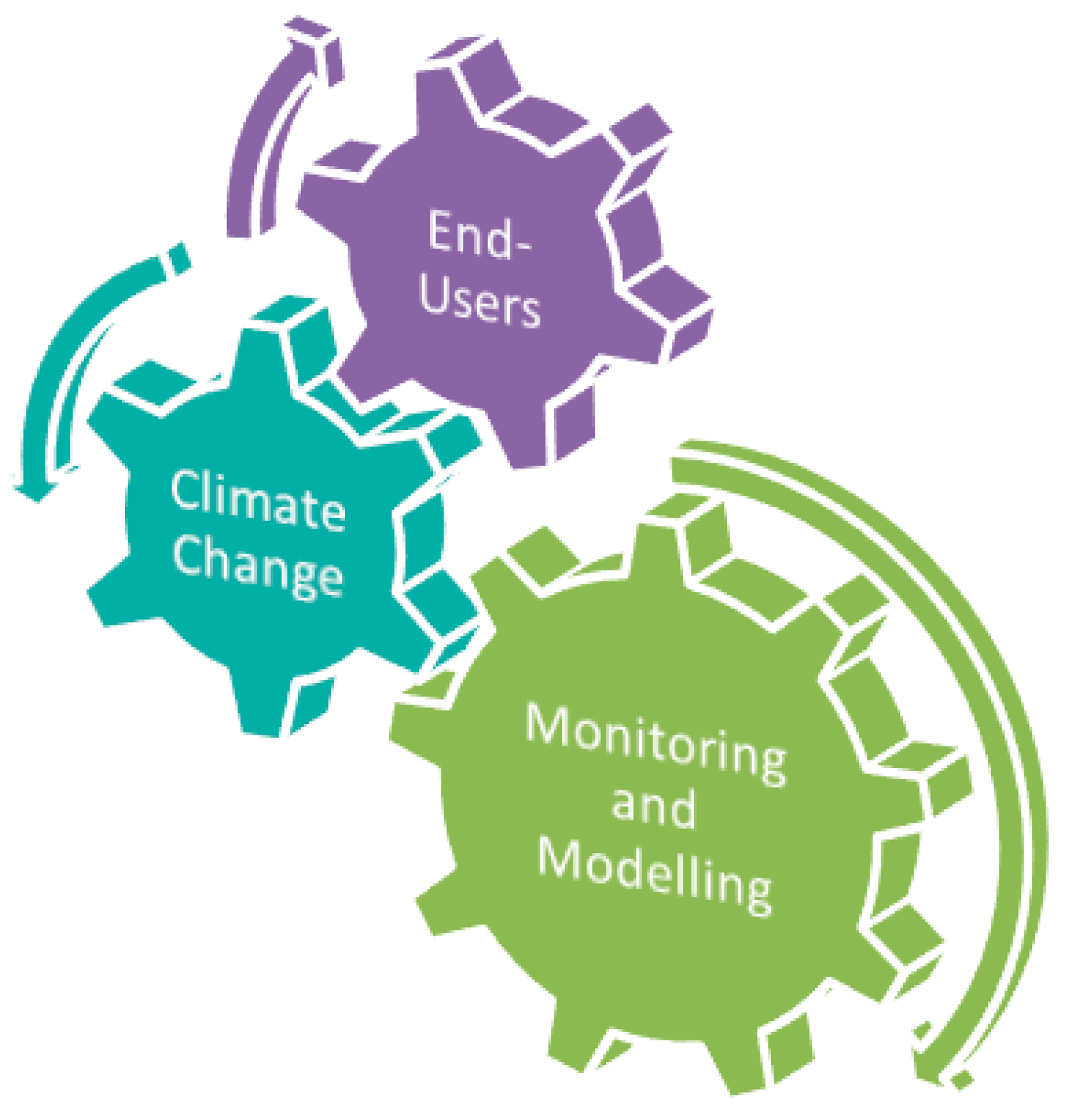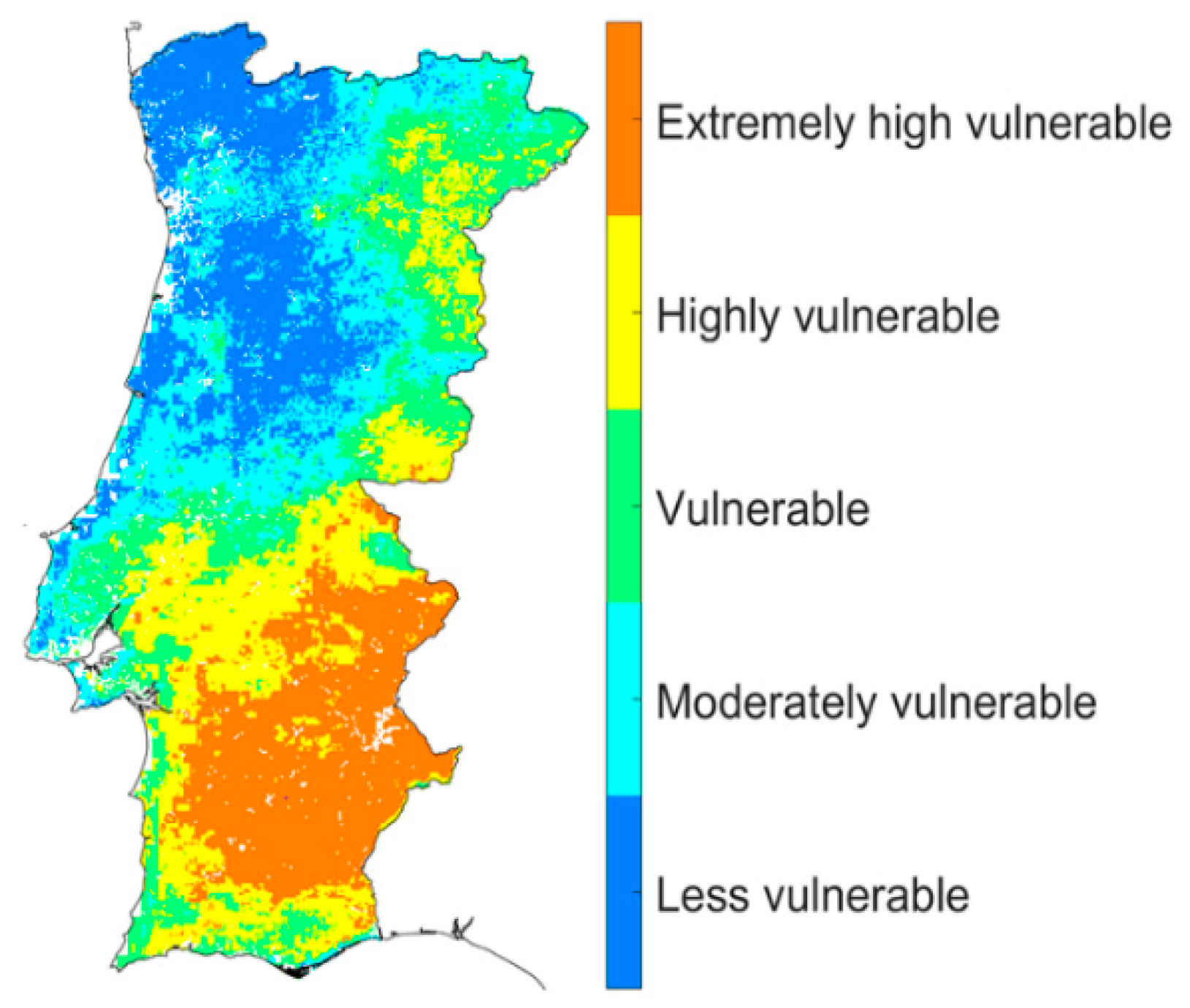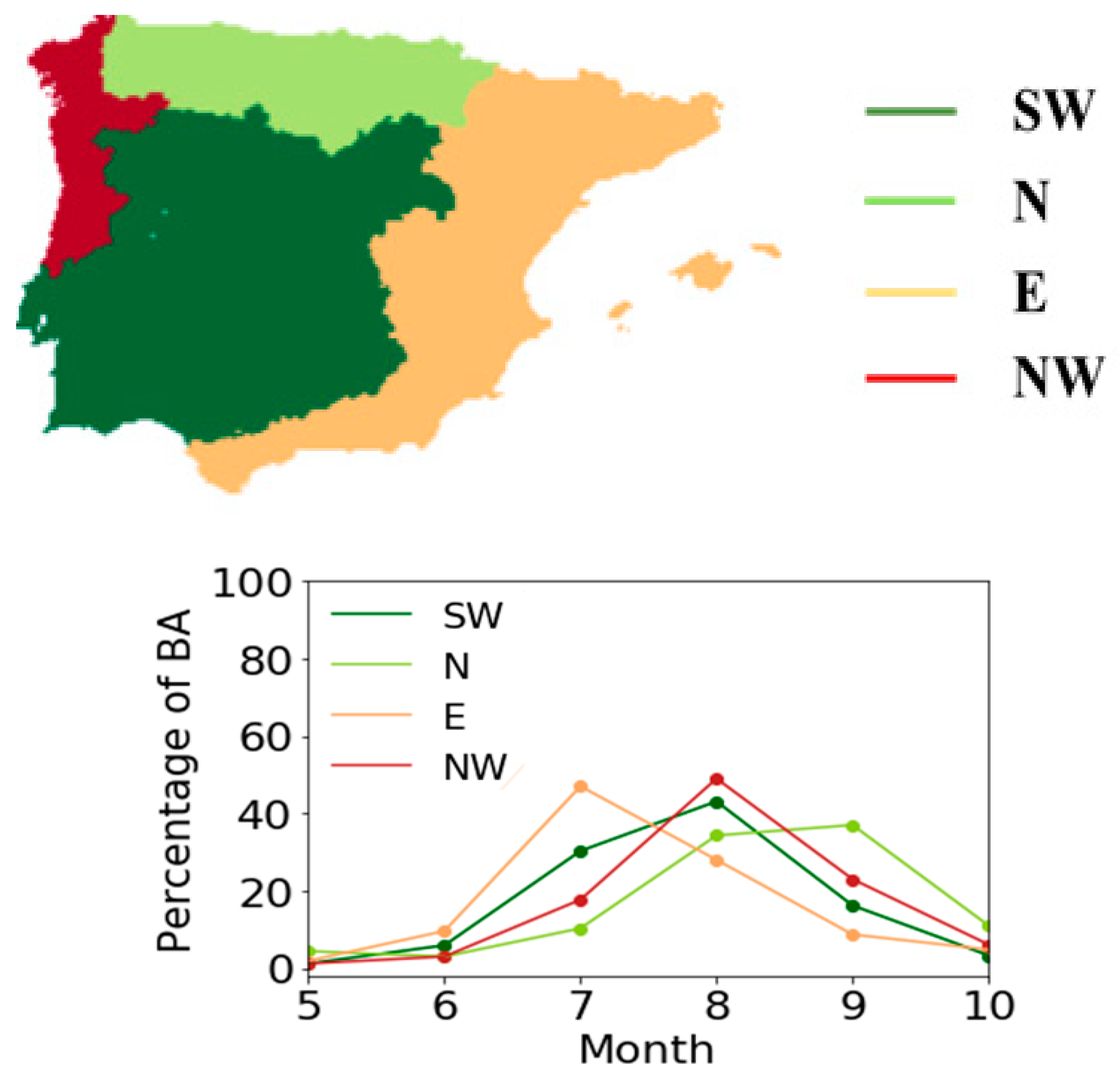1. Introduction
In recent decades, changes in climate have caused impacts on natural and human systems on all continents and across the oceans [
1]. Nevertheless, increases in climate variability have a greater effect on society than do changes in mean climate because it is more difficult to adapt to changes in extremes [
2]. Europe was struck by record breaking extreme events, namely the mega-heat waves of 2003 in Europe [
3] and 2010 in Russia [
4,
5], and the large droughts in southern Europe in 2005 [
6,
7], 2012 [
8] and 2016/2017 [
9]. The last major assessments performed by the IPCC on extreme events [
1,
10] confirm that a changing climate can lead to changes in the frequency, intensity, spatial extent, duration, and timing of weather and climate extremes that combined with larger exposure can result in unprecedented risk to humans and ecosystems [
1]. Several studies have also stressed the role played by recent climate change in the increased likelihood of occurrence of some of these extremes [
11,
12,
13,
14].
Risk assessments generally focus on univariate statistics even when multiple stressors are considered. For example, concurrent extreme droughts and heat waves can substantially affect vegetation health, prompting tree mortality, and thereby facilitating insect outbreaks and fires [
15]. In a future climate, elevated CO
2 may buffer effects of drought on vegetation productivity by increasing water use efficiency [
16]. In addition, droughts have the potential to trigger and intensify fires [
17] and can cause severe economic damage [
18], with no time for early-warnings in the case of flash-droughts [
18].
Thus, evidence on observed impacts as well as to climate change projected impacts on terrestrial ecosystems are mounting [
5,
7], suggesting significant vulnerability of both forest and agricultural ecosystems, namely being key drivers for vegetation stress [
7] and potentially responsible for crop yield and wood losses [
19,
20]. So, continuous monitoring of vegetation activity and a reliable estimation of droughts and heat waves’ impacts is crucial to reduce potential risks in the Iberian Peninsula.
Agricultural and forest risk management aims to mitigate crop and forest growth losses [
21,
22,
23,
24], highlighting the severe damages that can occur in the case of a concurrent effect of high temperature [
22]. Hence, the predictability and forecasting of extreme weather events play a major role in risk management to promote adaptation and mitigation measures that contribute to minimize the impacts resultant from these extreme events.
Traditionally, local risk management strategies focus only on short-term climatic events without considering long-term climate changes [
1], such as vegetation and soil moisture changes. General Circulation Models (GCMs) provide a powerful tool to evaluate recent trends in a broader temporal context and to investigate the underlying mechanisms [
25]. Nevertheless, currently used GCMs have coarse horizontal resolutions, being unable to represent many land-atmosphere interactions and systems that drive regional and local climate variability [
25]. Alternatively, the Regional Climate Models (RCMs), namely the Weather Research and Forecasting model (WRF, 2 km to 9 km resolutions), are physically consistent with regional and local circulations at finer horizontal and temporal scales [
25,
26].
2. Main Goals
The main goal of IMPECAF is to enhance the knowledge on Hot and Dry meteorological Extremes (HDE, heat waves, droughts, and flash-droughts) which affect the agricultural and forest ecosystems of the Iberian Peninsula. Despite the different temporal scales of these HDE, the concurrent or lagged effect of more than one of these phenomena may intensify the observed impacts [
1]. Moreover, their impacts can extend over large regions [
3,
5], differently affecting varied ecosystems [
7,
14,
17,
19,
20]. Despite differences in the spatial-temporal context on which each HDE occur [
1], they will all be treated from a multidisciplinary perspective considering past, present and future states of climate.
IMPECAF plans different actions to assess the risk of the impact of HDE on crop and wood losses, making use of currently available meteorological, hydrological and remote sensing data. Hence, IMPECAF will use drought indices which are useful for drought monitoring and early warning and will integrate short-and medium-term meteorological predictions and numerical simulations for better drought prediction. Moreover, IMPECAF will also assess the role of vegetation communities and carbon storage by ecosystems on drought and heat wave impacts. These tasks will allow designing efficient risk models and produce information which will help in risk mitigation and insurance planning.
IMPECAF is organized into three work packages (
Figure 1) encompassing seven tasks, and it uses a trans-disciplinary approach that includes innovative in-depth studies that combine drought and heat wave analyses at the Iberian scale. The project will rely on the accumulated experience of the project team on multivariable impact analysis of extreme events such as the recent mega-European heat waves of 2003 [
3,
5] and 2010 [
4,
5] or the outstanding droughts of 2005 and 2012 in the Iberian Peninsula [
6,
7,
8].
Finally, the outcomes of the project are expected to be available to the scientific community and general public, helping farmers, producers and insurance companies on the process of decision-making. This will be achieved through the development of appropriate measures for HDE mitigation in the forestry and agriculture sectors, both prior and during HDE occurrence. A bottom-up approach will be followed to guarantee stakeholder involvement from the start of the project and also after its completion, which will be ensured by the connection between the IPBeja and two Alentejo’s agriculture associations.
This project will benefit from the close collaboration with the stakeholders and end-users to ensure an adequate acceptance of the new products developed.
3. Results
3.1. Crops’ Sensitivity and Adaptive Capacity to Drought Occurrence
In the context of sustainable agricultural management, particularly under climate change, monitoring of drought events and assessing the vulnerability of agriculture to drought plays a crucial role [
27]. Drought episodes are very frequent in the Iberian Peninsula and an increase of frequency of these extreme events are expected in near future [
28,
29].
In this work a principal component analysis was performed based on information regarding the vulnerability components of exposure, sensitivity and adaptability of the agricultural system to drought with the final goal of generating maps of vulnerability of agriculture to drought in mainland Portugal.
It can be concluded that the Alentejo is an area of special attention because it is the area that has a higher vulnerability of crops to drought and that has the most agricultural area (
Figure 2). The method used is a fully statistical method that presents results according to a prior knowledge of the region and the data used.
3.2. B. Identification of Fire Weather Types Associated to the Occurrence of Large Fires in Iberia
The Mediterranean region is characterized by the frequent occurrence of summer wildfires representing an environmental and socioeconomic burden. Some Mediterranean countries (or provinces) are particularly prone to Large Fires (LF), namely Portugal, Galicia, Greece, and southern France [
30,
31,
32]. On the other hand, the Mediterranean basin corresponds to a major hotspot of climate change, and anthropogenic warming is expected to increase the total burned area due to fires in Mediterranean Europe [
33].
Here, we propose to classify summer large fires for four regions of Iberia according to their local-scale weather conditions (i.e., temperature, relative humidity, wind speed) and fire danger weather indices (
Figure 3). Composite analysis was used to investigate the impact of local and regional climate drivers at different time scales, and to identify distinct climatologies associated to the occurrence of LF in the Iberian Peninsula. The regions present significantly different values of burned area from which a large fire is considered.
The application of the cluster analysis to aggregate fire day standardized anomalies for the variables identified by the PCA (Principal Component Analysis) can be observed in
Figure 4, showing that in all four regions, three distinct Fire Weather Types were identified. The FWT_1, depicted in blue, is characterised by high wind speed anomalies (above one std). The FWT_2, in green, is represented by anomalies of the various variables within the normal (bellow one std). Finally, FWT_3, in red, is characterized by high positive temperature anomalies (above one std) and strong negative relative humidity anomalies (above one std). However, the value of the anomalies that distinguish each FWT is different for the four regions.
4. Conclusions
The assessment of the impact of extreme weather conditions, in particular the occurrence of droughts and heat waves, in the production of cereals is of great importance, since the extreme episodes in the Iberian Peninsula have been more frequent and more intense, having impacts on vegetation. In a context of climate change, the sustainable production of natural resource, in particular as regards the plant ecosystems, is a challenge that urge to present solutions. In this sense, the modelling of agricultural and forestry biomass productivity is crucial, aiming at sustainable and informed management, in particular regarding mitigation or adaptation measures to frequent extreme events. At the same time, the modelling of forestry and agriculture biomass allows access to existing insurance systems. Risk models for agriculture are based on the experience and know-how of the team members in crop modelling, and statistical methods. Moreover, agro-meteorological projects use data freely available, including remote detection data of high temporal resolution. The models will integrate a tool, available online, easy to use and to interpret, allowing a supported decision by farmers, foresters, managers, civil protection, among others.
We expect to be able to develop a dialogue and foster linkages between the scientific community, policy makers, and end-users within the context of IMPECAF.
Author Contributions
Conceptualization, A.R. and C.G.; Methodology, A.R. and C.G.; Formal analysis, I.V., P.P. and C.A.; investigation, A.R., C.G., I.V., P.P. and C.A.; resources, S.R., P.O.eS., A.R. and C.G.; writing—original draft preparation, I.R., P.O.eS., A.R. and C.G.; writing—review and editing, A.R. and C.G.; visualization, X.X.; supervision, A.R. and C.G.; project administration, A.R.; funding acquisition, A.R., C.G., S.R.
Funding
This work was funded by national funds by the FCT (Fundação para a Ciência e Tecnologia, Portugal) under the scope of project IMPECAF (FCT, PTDC/CTA-CLI/28902/2017).
Conflicts of Interest
The authors declare no conflict of interest.
References
- IPCC—Intergovernmental Panel on Climate Change. Managing the Risks of Extreme Events and Disasters to Advance Climate Change Adaptation, in A Special Report of Working Groups I and II of the Intergovernmental Panel on Climate Change; Field, C.B., Barros, V., Stocker, T.F., Qin, D., Dokken, D.J., Ebi, K.L., Eds.; Cambridge University Press: Cambridge, UK; New York, NY, USA, 2012; p. 582. [Google Scholar]
- Seneviratne, S.; Luthi, D.; Litschi, M.; Schar, C. Land–atmosphere coupling and climate change in Europe. Nat. Lett. 2006, 443. [Google Scholar] [CrossRef] [PubMed]
- Trigo, R.M.; García-Herrera, R.; Díaz, J.; Trigo, I.F.; Valente, M.A. How exceptional was the early August 2003 heatwave in France? Geophys. Res. Lett. 2005, 32. [Google Scholar] [CrossRef]
- Barriopedro, D.; Fisher, E.; Luterbacher, J.; Trigo, R.M.; García-Herrera, R. The hot summer of 2010: Redrawing the temperature record map of Europe. Science 2011, 322, 220. [Google Scholar] [CrossRef] [PubMed]
- Bastos, A.; Gouveia, C.M.; Trigo, R.M.; Running, S.W. Analysing the spatio-temporal impacts of the 2003 and 2010 extreme heatwaves on plant productivity in Europe. Biogeosciences 2014, 11, 3421–3435. [Google Scholar] [CrossRef]
- Garcia-Herrera, R.; Paredes, D.; Trigo, R.M.; Trigo, I.F.; Hernández, H.; Barriopedro, D.; Mendes, M.T. The outstanding 2004-2005 drought in the Iberian Peninsula: Associated atmospheric circulation. J. Hydrometeorol. 2007, 8, 483–498. [Google Scholar] [CrossRef]
- Gouveia, C.; Trigo, R.M.; DaCamara, C.C. Drought and Vegetation Stress Monitoring in Portugal using Satellite Data. Nat. Hazards Earth Syst. Sci. 2009, 9, 1–11. [Google Scholar] [CrossRef]
- Trigo, R.M.; Añel, J.; Barriopedro, D.; García-Herrera, R.; Gimeno, L.; Nieto, R.; Castillo, R.; Allen, M.R.; Massey, N. The record Winter drought of 2011-12 in the Iberian Peninsula, in Explaining Extreme Events of 2012 from a Climate Perspective. Bull. Am. Meteorol. Soc. 2013, 94, S41–S45. [Google Scholar]
- García-Herrera, R.; Garrido-Perez, J.M.; Barriopedro, D.; Ordóñez, C.; Vicente-Serrano, S.M.; Nieto, R.; Gimeno, L.; Sori, R.; Yiou, P. The European 2016/2017 drought. J. Clim. 2019. [Google Scholar] [CrossRef]
- IPCC—Intergovernmental Panel on Climate Change. Climate Change 2014: Mitigation of Climate Change; Cambridge University Press: New York, NY, USA, 2014. [Google Scholar]
- Donat, M.G.; Alexander, L.V.; Yang, H.; Durre, I.; Vose, R.; Dunn, R.J.H.; Willett, K.M.; Aguilar, E.; Brunet, M.; Caesar, J.; et al. Updated analyses of temperature and precipitation extreme indices since the beginning of the twentieth century: The HadEX2 dataset. J. Geophys. Res. Atmos. 2013, 118, 2098–2118. [Google Scholar] [CrossRef]
- Sillmann, J.; Kharin, V.V.; Zhang, X.; Zwiers, F.W.; Bronaugh, D. Climate extremes indices in the CMIP5 multimodel ensemble: Part 1. Model evaluation in the present climate. J. Geophys. Res. Atmos. 2013, 118, 1716–1733. [Google Scholar] [CrossRef]
- Seneviratne, S.; Donat, M.G.; Mueller, B.; Alexander, L.V. No pause in the increase of hot temperature extremes. Nat. Clim. Chang. 2014, 4, 161–163. [Google Scholar] [CrossRef]
- Ummenhofer, C.C.; Meehl, G.A. Extreme weather and climate events with ecological relevance: A review. Philos. Trans. R. Soc. B 2017, 372. [Google Scholar] [CrossRef] [PubMed]
- Mazdiyasni, O.; AghaKouchak, A. Substantial increase in concurrent droughts and heatwaves in the United States. Proc. Natl. Acad. Sci. USA 2015, 112, 11484–11489. [Google Scholar] [CrossRef] [PubMed]
- Zhu, Z.; Piao, S.; Myneni, R.B.; Huang, M.; Zeng, Z.; Canadell, J.G.; Ciais, P.; Sitch, S.; Friedlingstein, P.; Arneth, A.; et al. Greening of the Earth and its drivers. Nat. Clim. Chang. Adv. Online Publ. 2016, 6, 791–795. [Google Scholar] [CrossRef]
- Russo, A.; Gouveia, C.M.; Páscoa, P.; DaCamara, C.C.; Sousa, P.M.; Trigo, R.M. Assessing the role of drought events on wildfires in the Iberian Peninsula. Agric. For. Meteorol. 2017. [Google Scholar] [CrossRef]
- Mo, K.C.; Lettenmaier, D.P. Heat wave flash droughts in decline. Geophys. Res. Lett. 2015, 42, 2823–2829. [Google Scholar] [CrossRef]
- Popova, Z.; Ivanova, M.; Martins, D.; Pereira, L.S.; Doneva, K.; Alexandrov, V.; Kercheva, M. Vulnerability of Bulgarian agriculture to drought and climate variability with focus on rainfed maize systems. Nat. Hazards 2014, 74, 865–886. [Google Scholar] [CrossRef]
- Eilmann, B.; Zweifel, R.; Buchmann, N.; Pannatier, E.G.; Rigling, A. Drought alters timing, quantity, and quality of wood formation in Scots pine. J. Exp. Bot. 2011, 62, 2763–2771. [Google Scholar] [CrossRef]
- Iglesias, A.; Quiroga, S. Measuring the risk of climate variability to cereal production at five sites in Spain. Clim. Res. 2007, 34, 47–57. [Google Scholar] [CrossRef]
- Adams, H.D.; Guardiola-Claramonte, M.; Barron-Gafford, G.A.; Villegas, J.C.; Breshears, D.D.; Zhou, C.B.; Troch, P.A.; Huxman, T.E. Temperature sensitivity of drought-induced tree mortality portends increased regional die-off under global-change-type drought. Proc. Natl. Acad. Sci. USA 2009, 106, 7063–7066. [Google Scholar] [CrossRef]
- Dalezios, N.R.; Blanta, A.; Spyropoulos, N.V.; Tarquis, A.M. Risk identification of agricultural drought for sustainable Agroecosystems. Nat. Hazards Earth Syst. Sci. 2014, 14, 2435–2448. [Google Scholar] [CrossRef]
- Albert, M.; Hansen, J.; Nagel, J.; Schmidt, M.; Spellmann, H. Assessing risks and uncertainties in forest dynamics under different management scenarios and climate change. For. Ecosyst. 2015, 2, 1–21. [Google Scholar] [CrossRef]
- Soares, P.M.M.; Cardoso, R.M.; Medeiros, J.; Miranda, P.M.A.; Belo-Pereira, M.; Espirito-Santo, F. WRF High Resolution Dynamical Downscaling of ERA-Interim for Portugal. Clim. Dyn. 2012, 39, 2497–2522. [Google Scholar] [CrossRef]
- Cardoso, R.M.; Soares, P.M.M.; Miranda, P.M.A.; Belo-Pereira, M. WRF high resolution simulation of Iberian mean and extreme precipitation climate. Int J. Clim. 2013, 33, 2591–2608. [Google Scholar] [CrossRef]
- Alonso, C.; Gouveia, C.; Russo, A.; daCamara, C. Avaliação da vulnerabilidade da agricultura à seca em Portugal Continental, APMG2019—11º Simpósio de Meteorologia e Geofísica da APMG. Proceedings. Cascais. 2019.
- Guerreiro, S.B.; Kilsby, C.; Fowler, H.J. Assessing the threat of future megadrought in Iberia. Int. J. Clim. 2017, 37, 5024–5034. [Google Scholar] [CrossRef]
- Dubrovský, M.; Hayes, M.; Duce, P.; Trnka, M.; Svoboda, M.; Zara, P. Multi-GCM projections of future drought and climate variability indicators for the Mediterranean region. Reg. Environ. Chang. 2014, 14, 1907–1919. [Google Scholar] [CrossRef]
- Trigo, R.M.; Pereira, J.M.C.; Pereira, M.G.; Mota, B.; Calado, T.J.; Dacamara, C.C.; Santo, F.E. Atmospheric conditions associated with the exceptional fire season of 2003 in Portugal. Int J. Clim. 2006, 26, 1741–1757. [Google Scholar] [CrossRef]
- Ruffault, J.; Moron, V.; Trigo, R.M.; Curt, T. Objective identification of multiple large fire climatologies: An application to a Mediterranean ecosystem. Environ. Res. Lett. 2016, 11. [Google Scholar] [CrossRef]
- Pinto, M.M.; DaCamara, C.C.; Trigo, I.F.; Trigo, R.M.; Turkman, K.F. Fire danger rating over Mediterranean Europe based on fire radiative power derived from Meteosat. Nat. Hazards Earth Syst. Sci. 2018, 18, 515–529. [Google Scholar] [CrossRef]
- Sousa, P.M.; Trigo, R.M.; Pereira, M.G.; Bedia, J.; Gutiérrez, J.M. Different approaches to model future burnt area in the Iberian Peninsula. Agric. For. Meteorol. 2015, 202, 11–25. [Google Scholar] [CrossRef]
© 2019 by the authors. Licensee MDPI, Basel, Switzerland. This article is an open access article distributed under the terms and conditions of the Creative Commons Attribution (CC BY) license (http://creativecommons.org/licenses/by/4.0/).










